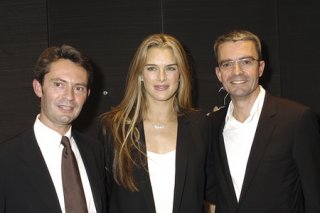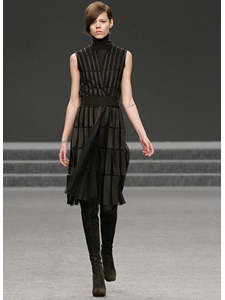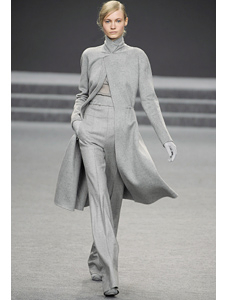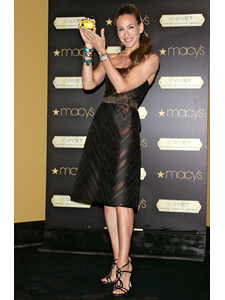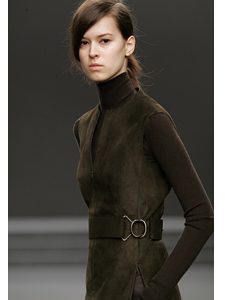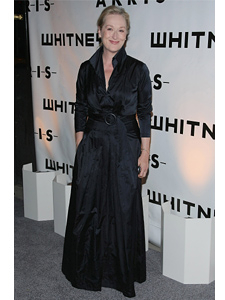Selling $4,000 Jackets in a Slowdown
Akris's Tactic: Intensify Focus
On High-Powered Women;
Sleeper Brand Outsells Chanel
by Christina Binkley
Akris designer Albert Kriemler last fall spent three days searching for crepe fabric at a Paris textile-industry trade show, with his cellphone shut down -- incommunicado.
He wanted to find the lightest possible couture-quality crepe to create all-season clothes for working women. Cost wasn't an issue -- even with the current financial straits of the retail and luxury industries. "I cannot work with cheap fabric," Mr. Kriemler said in March, a day after his Paris runway show. He fingered a pleated dress with three layers of soft tulle that took four days to drape and pleat. Each stitch of the angled pleats, he said precisely, was 0.7 centimeter higher than the last.
It might seem the wrong moment for this: uncompromisingly expensive fabrics and labor-intensive designs. At $9,950, the pleated tulle gown is aimed at a rarefied customer group. But Akris isn't taking a cost-cutting approach to surviving the current slowdown. Instead, it's doubling down on pleasing its core customers -- powerful women, often career women, who seek modern, innovative clothing.
Rather than following the currently popular flirty or romantic ingenue trends, Akris imbues wearers such as Condoleezza Rice with an attitude of sleek command. Akris targets chairwomen of the board and other high-powered women, though it's less overtly dressy than archrival Armani.
As "fit models" on which to shape its designs, Akris employs not only the typical waifs but also size 12 and 14 women, and it cuts large sizes to ensure they'll cover the sturdiest bras. Mr. Kriemler last year was one of the first luxury designers to create high-waisted, wide-legged pants, back when most of the fashion industry was still designing low-rise pants aimed at the youthful market. He says the woman he designs for "travels, she packs suitcases, she wants to get ahead."
Functionality isn't the current mode in the fashion world. But Akris is a sleeper brand that often outsells the elegant office armor of Armani, St. John, Chanel and Piazza Sempione at stores such as Bergdorf Goodman. Akris is among the top 10 sellers for Saks Fifth Avenue, says Joseph Boitano, Saks's top merchandising executive. "They're a very important brand for us, and they truly are a brand that is focused on ready-to-wear, which is a unique situation," says Mr. Boitano.
To Karen Firestone, president of Aureus Asset Management in Boston, the clothes "express breeding." With a closet full of Akris, she has worn a summer pearl-gray jacket and black skirt with a scalloped hem to meetings in the Middle East and has worn a tomato-red Akris coat for five seasons. "It's not all new, splashy, fast-paced style," she says.
Theresa Havell, president of Havell Capital Management LLC, a private investment fund in New York, calls Akris "a wardrobe workhorse." She says her Akris clothes, including a sleeveless black wool crepe dress with a cropped, fitted jacket, travel well in a suitcase and transition with ease from day to night.
When it comes to prices, though, she says Akris is "at the top of the food chain."
Indeed, the challenge for the Swiss, family-owned company now is to navigate an economy in which fewer people are buying $5,000 suits. I overheard an American retail buyer at Akris's show here in March, when retail stores were beginning to slash prices on current-season inventories, telling her colleague, "You've got to have a reason in this economy to justify having a $4,000 jacket."
Caroline Brown, a former Armani executive who is Akris's chief executive in the U.S., concedes that she's concerned about the economic climate. "Any company that isn't being cautious right now wouldn't be doing its job." She noted that the shift to making seasonless clothes and clothes that will last longer stylistically (without doo-dads that date them) is partly a response to shoppers' concerns about buying frivolous clothes that last only a season or two. Still, she says, the label's fall sales so far are ahead of last year's.
She notes that the traditional path to growth would be to pursue licensing deals to make underwear, accessories and the like -- something the Kriemler family declines to do. Instead, the plan is to allow profit margins to shrink and to focus closely on what customers are asking for, which these days is seasonless styles -- for instance, colors and patterns that can be worn year-round -- and lighter fabrics.
Being family-owned, Akris needn't answer to the quarterly demands of investors. The ability to cut profit margins to ride out a rough period is a "luxury," says Peter Kriemler, Albert's brother and the company's president.
In fact, Akris defies virtually every rule of big luxury-brand operations established by successful rivals such as Chanel and Louis Vuitton. The company offers no high-profit-margin perfumes, handbags, shoes or logo-wear. It makes 100% of its clothes in Switzerland, a country off the radar of the fashion industry with one of the world's most expensive labor markets.
The nonconformist approach may be inspired by Akris's location far from the hubs of fashion in St. Gallen, Switzerland, on the border of the bucolic Appenzell region. Within Switzerland, this German-speaking area, known for its cheeses, is the butt of jokes about its rural populace. But Switzerland is also known for its watchmaking, and Akris clothes are made with a costly perfectionism. Albert Kriemler refuses to hire inexpensive free-lancers and insists that a tailor who makes pants apprentice for two years and then specialize in only pants.
Thus prices won't fall -- though they won't rise -- in the coming season. Akris's 2009 collections will feature more fluid fabrics -- including the crepe that Mr. Kriemler found. Many of the colors and fabrics are based on Akris archives from a decade ago. Mr. Kriemler says in his precise way, "The fabric is essential to the success of the collection."
wsj.com
Akris's Tactic: Intensify Focus
On High-Powered Women;
Sleeper Brand Outsells Chanel
by Christina Binkley
Akris designer Albert Kriemler last fall spent three days searching for crepe fabric at a Paris textile-industry trade show, with his cellphone shut down -- incommunicado.
He wanted to find the lightest possible couture-quality crepe to create all-season clothes for working women. Cost wasn't an issue -- even with the current financial straits of the retail and luxury industries. "I cannot work with cheap fabric," Mr. Kriemler said in March, a day after his Paris runway show. He fingered a pleated dress with three layers of soft tulle that took four days to drape and pleat. Each stitch of the angled pleats, he said precisely, was 0.7 centimeter higher than the last.
It might seem the wrong moment for this: uncompromisingly expensive fabrics and labor-intensive designs. At $9,950, the pleated tulle gown is aimed at a rarefied customer group. But Akris isn't taking a cost-cutting approach to surviving the current slowdown. Instead, it's doubling down on pleasing its core customers -- powerful women, often career women, who seek modern, innovative clothing.
Rather than following the currently popular flirty or romantic ingenue trends, Akris imbues wearers such as Condoleezza Rice with an attitude of sleek command. Akris targets chairwomen of the board and other high-powered women, though it's less overtly dressy than archrival Armani.
As "fit models" on which to shape its designs, Akris employs not only the typical waifs but also size 12 and 14 women, and it cuts large sizes to ensure they'll cover the sturdiest bras. Mr. Kriemler last year was one of the first luxury designers to create high-waisted, wide-legged pants, back when most of the fashion industry was still designing low-rise pants aimed at the youthful market. He says the woman he designs for "travels, she packs suitcases, she wants to get ahead."
Functionality isn't the current mode in the fashion world. But Akris is a sleeper brand that often outsells the elegant office armor of Armani, St. John, Chanel and Piazza Sempione at stores such as Bergdorf Goodman. Akris is among the top 10 sellers for Saks Fifth Avenue, says Joseph Boitano, Saks's top merchandising executive. "They're a very important brand for us, and they truly are a brand that is focused on ready-to-wear, which is a unique situation," says Mr. Boitano.
To Karen Firestone, president of Aureus Asset Management in Boston, the clothes "express breeding." With a closet full of Akris, she has worn a summer pearl-gray jacket and black skirt with a scalloped hem to meetings in the Middle East and has worn a tomato-red Akris coat for five seasons. "It's not all new, splashy, fast-paced style," she says.
Theresa Havell, president of Havell Capital Management LLC, a private investment fund in New York, calls Akris "a wardrobe workhorse." She says her Akris clothes, including a sleeveless black wool crepe dress with a cropped, fitted jacket, travel well in a suitcase and transition with ease from day to night.
When it comes to prices, though, she says Akris is "at the top of the food chain."
Indeed, the challenge for the Swiss, family-owned company now is to navigate an economy in which fewer people are buying $5,000 suits. I overheard an American retail buyer at Akris's show here in March, when retail stores were beginning to slash prices on current-season inventories, telling her colleague, "You've got to have a reason in this economy to justify having a $4,000 jacket."
Caroline Brown, a former Armani executive who is Akris's chief executive in the U.S., concedes that she's concerned about the economic climate. "Any company that isn't being cautious right now wouldn't be doing its job." She noted that the shift to making seasonless clothes and clothes that will last longer stylistically (without doo-dads that date them) is partly a response to shoppers' concerns about buying frivolous clothes that last only a season or two. Still, she says, the label's fall sales so far are ahead of last year's.
She notes that the traditional path to growth would be to pursue licensing deals to make underwear, accessories and the like -- something the Kriemler family declines to do. Instead, the plan is to allow profit margins to shrink and to focus closely on what customers are asking for, which these days is seasonless styles -- for instance, colors and patterns that can be worn year-round -- and lighter fabrics.
Being family-owned, Akris needn't answer to the quarterly demands of investors. The ability to cut profit margins to ride out a rough period is a "luxury," says Peter Kriemler, Albert's brother and the company's president.
In fact, Akris defies virtually every rule of big luxury-brand operations established by successful rivals such as Chanel and Louis Vuitton. The company offers no high-profit-margin perfumes, handbags, shoes or logo-wear. It makes 100% of its clothes in Switzerland, a country off the radar of the fashion industry with one of the world's most expensive labor markets.
The nonconformist approach may be inspired by Akris's location far from the hubs of fashion in St. Gallen, Switzerland, on the border of the bucolic Appenzell region. Within Switzerland, this German-speaking area, known for its cheeses, is the butt of jokes about its rural populace. But Switzerland is also known for its watchmaking, and Akris clothes are made with a costly perfectionism. Albert Kriemler refuses to hire inexpensive free-lancers and insists that a tailor who makes pants apprentice for two years and then specialize in only pants.
Thus prices won't fall -- though they won't rise -- in the coming season. Akris's 2009 collections will feature more fluid fabrics -- including the crepe that Mr. Kriemler found. Many of the colors and fabrics are based on Akris archives from a decade ago. Mr. Kriemler says in his precise way, "The fabric is essential to the success of the collection."
wsj.com

